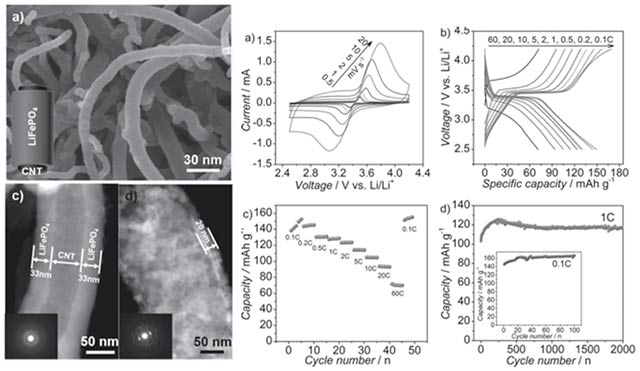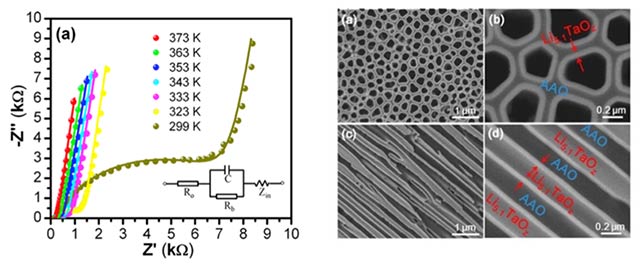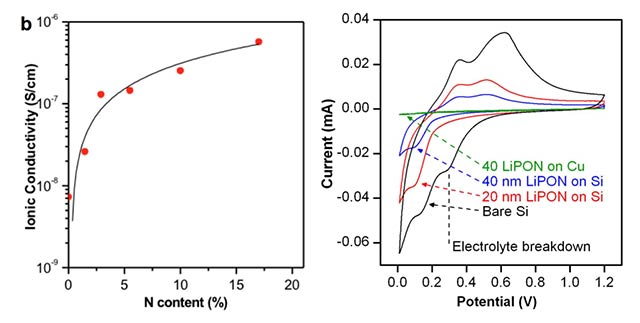
Thin Film Electrode, Electrolytes and Passivation Layers
By implementing lithium-based ALD films in nanostructured 3D lithium-ion batteries, significant gains in power density, cycling performances during charge/discharge, and safety have been recently reported.
Using 91���� CNT ALD platforms, electrochemically active materials with high specific capacity such as LiCoO2, LiMn2O4 ternaries or lithium transition metal phosphate quarternaries (e.g., LiFePO4) have been successfully deposited on high aspect ratio 3D nanostructures, leading to fast ion transport and increased power density.
Solid state electrolytes, e.g., lithium phosphate[8], lithium tantalate [12] or LiPON [2] have been deposited both in Savannah® and Fiji® platforms to achieve tunable high ionic conductivity .
Very thin passivation layers such as Al2O3 (<1nm) have also been shown to significantly improve capacity retention of LIBs during electrochemical cycling by inhibiting the dissolution of the transition metal while enabling the diffusion of the lithium ions through the passivation layers.[15] Lately Xiao and al. have optimized the performance layer of LiNi0.5Mn1.5O4 cathode materials using an electrochemically active FePO4 coating[6].
ALD Benefits for 3D Li-ion batteries
- Higher Power
- Shorter diffusion path in 3D nanostructures lead to higher power density
- Discharge Rate
- Improved charge / discharge rate from high surface area ratio
- Cycle Life
- Improved cycle life using ALD passivation layers and low stress films
- Safety
- Non-flammable solid-state electrolytes
Conformal LiFePO4 cathode film deposited on carbon nanotube exhibit excellent discharge capacity and rate capability [10]
Deposition of Li5.1TaO2 solid electrolyte in high aspect ratio AAO with Li+ ion conductivity of 2E-8S/cm [13]
In-situ XPS demonstration carbon-free Li2O ALD with LiOtBu / H2O in Fiji®
LiPON solid electrolyte deposited by ALD. Ionic conductivity is tuned by %N content in film [2]
REFERENCES – Recent publications done on 91���� CNT ALD platforms
- Liu, J. et al. Atomically Precise Growth of Sodium Titanates as Anode Materials for High-Rate and Ultralong Cycle-Life Sodium-Ion Batteries. J. Mater. Chem. A (2015). doi:10.1039/C5TA08435K
- Kozen, A. C., Pearse, A. J., Lin, C.-F., Noked, M. & Rubloff, G. W. Atomic Layer Deposition of the Solid Electrolyte LiPON. Chem Mater 150709110756002–13 (2015). doi:10.1021/acs.chemmater.5b01654
- Ahmed, B. et al. Surface Passivation of MoO3 Nanorods by Atomic Layer Deposition toward High Rate Durable Li Ion Battery Anodes. Acs Appl Mater Inter 150612140338000–10 (2015). doi:10.1021/acsami.5b03395
- Ahmed, B., Anjum, D. H., Hedhili, M. N. & Alshareef, H. N. Mechanistic Insight into the Stability of HfO2‐Coated MoS2 Nanosheet Anodes for Sodium Ion Batteries. Small n/a–n/a (2015). doi:10.1002/smll.201500919
- Kozen, A. C. et al. Next-Generation Lithium Metal Anode Engineering via Atomic Layer Deposition. ACS Nano 150513155622005–30 (2015). doi:10.1021/acsnano.5b02166
- Xiao, B. et al. Unravelling the Role of Electrochemically Active FePO4 Coating by Atomic Layer Deposition for Increased High‐Voltage Stability of LiNi0.5Mn1.5O4 Cathode Material. Advanced Science n/a–n/a (2015). doi:10.1002/advs.201500022
- Liu, J. et al. Atomic layer deposition of amorphous iron phosphates on carbon nanotubes as cathode materials for lithium-ion batteries. Electrochimica Acta (2014). doi:10.1016/j.electacta.2014.12.158
- Wang, B. et al. Atomic layer deposition of lithium phosphates as solid-state electrolytes for all-solid-state microbatteries. Nanotechnology 25, 504007 (2014).
- Kozen, A. C. et al. Atomic Layer Deposition and In-situ Characterization of Ultraclean Lithium Oxide and Lithium Hydroxide. J. Phys. Chem. C 141106012144006 (2014). doi:10.1021/jp509298r
- Liu, J. et al. Rational Design of Atomic-Layer-Deposited LiFePO4 as a High-Performance Cathode for Lithium-Ion Batteries. Advanced Materials n/a–n/a (2014). doi:10.1002/adma.201401805
- Yesibolati, N. et al. SnO2 Anode Surface Passivation by Atomic Layer Deposited HfO2 Improves Li-Ion Battery Performance. Small n/a–n/a (2014). doi:10.1002/smll.201303898
- Lecordier, L., Insitu process optimization of lithium-based multicomponent oxides, ALD2014, Kyoto Japan
- Liu, J. et al. Atomic Layer Deposition of Lithium Tantalate Solid-State Electrolytes. J. Phys. Chem. C 117, 20260–20267 (2013).
- Kim, H. et al. Plasma‐Enhanced Atomic Layer Deposition of Ultrathin Oxide Coatings for Stabilized Lithium–Sulfur Batteries. Adv. Energy Mater. 3, 1308–1315 (2013).
- Bettge, M. et al. Improving high-capacity Li1.2Ni0.15Mn0.55Co0.1O2-based lithium-ion cells by modifiying the positive electrode with alumina. J Power Sources 233, 346–357 (2013).
- Lee, J.-T., Wang, F.-M., Cheng, C.-S., Li, C.-C. & Lin, C.-H. Low-temperature atomic layer deposited Al2O3 thin film on layer structure cathode for enhanced cycleability in lithium-ion batteries. Electrochimica Acta 5,5 4002–4006 (2010).




